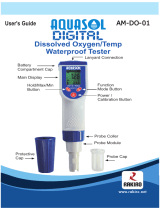
3
TABLE OF CONTENTS
4
4
5
7
9
10
14
18
23
24
26
5
5
8
10
13
16
21
23
25
28
31
28
29
Included ............................................................................................................................
Safety Measures .................................................................................................................
Description .........................................................................................................................
Diagram ............................................................................................................................
Product Diagram ........................................................................................................
Probe Diagram ...........................................................................................................
Keypad Function ........................................................................................................
Guide to Indicators .....................................................................................................
Setup/Installation ...............................................................................................................
Setting Up edge
® DO
...................................................................................................
Electrode & Probe Connections .....................................................................................
General Setup ............................................................................................................
Logging Function .......................................................................................................
Viewing Logged Data ..................................................................................................
PC & Storage Interface ................................................................................................
Operational Guide ...............................................................................................................
Dissolved Oxygen Setup ..............................................................................................
Dissolved Oxygen Probe Diagram .................................................................................
Dissolved Oxygen Meter Configuration ..........................................................................
Dissolved Oxygen Calibration .......................................................................................
Dissolved Oxygen Calibration Messages ........................................................................
Dissolved Oxygen GLP Information ...............................................................................
Dissolved Oxygen Measurements .................................................................................
Maintenance ......................................................................................................................
Dissolved Oxygen Probe Maintenance ...........................................................................
Troubleshooting Guide ................................................................................................
Specifications .....................................................................................................................
Accessories .........................................................................................................................
32
31
34
33


























